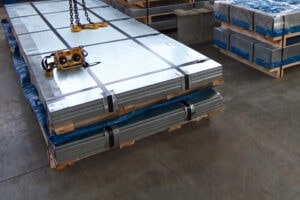Intro
A lot of parts’ success depends on what material is used for the part. Making a car engine out of plastic? Not the best idea. Even within the world of metals, there are so many options to pick between. In this quick guide, we’ll discuss two steels that are commonly confused: galvanneal and galvanized steel.
We’ll discuss what they are, how they work, and the major differences between the two. More importantly, we’ll figure out which option is right for your next project.
What Is Galvanized Steel?
To understand both of these materials, we should start with galvanized steel. If you didn’t know, this material is regular steel that goes through a galvanization process. What does the galvanization process look like? It’s a multi-step process that includes cleaning, pickling, fluxing, galvanization, and post-processing before you have the final material.
This process creates a strong coating that goes around the piece of steel. Due to this, it’s usually better to do a galvanization process after the steel part is fully machined, welded, drilled, and fabricated.
Benefits of Galvanized Steel
There are a lot of reasons why you might use galvanized steel in your next project:
- It makes your part stronger. The main purpose of galvanization is to make your parts stronger. This coating will make your parts more resilient, stronger, and more resistant to corrosion.
- Add longevity to each piece. Thanks to better mechanical properties and weather resilience, each part made with galvanized steel will last longer than its carbon steel counterpart.
- Lower long-term operating costs. With galvanized steel, you’ll have fewer failures over time, resulting in less downtime and less money spent replacing parts.
When Galvanized Steel Is Typically Used
The most common places you’ll find galvanized steel is on a construction site or in a bag of bolts. Galvanized bolts are incredibly common, and they’re much stronger than zinc-plated or carbon steel bolts. 
On a construction site, galvanized nails can be used to add more durability and strength to connection points.
Within cars and bikes, you might find galvanized steel framework. This treatment will make the frame look nicer, resist more corrosion, and help boost the lifespan of each assembly.
What Is Galvanneal?
The galvannealing process is a combination of galvanizing and annealing, hence the name. After doing the full galvanization process, the part will then get annealed in an oven set to around 1050°F. This temperature changes the steel on a molecular level, creating an even stronger part.
More specifically, the temperature melts the included iron while the steel is still mostly-solid. The molten iron will move to the outside of the part and create a coating. This creates a rougher finish, but you can ask for cold rolling to smooth out the face.
Benefits of Galvanneal
Galvanneal boasts all of the same benefits of galvanized steel, but it offers even more. For instance, it has even more strength, corrosion resistance, and durability than galvanized steel.
When Galvanneal Is Typically Used
Galvanneal can be used as either a sheet metal or stock plate. You’ll see it used very commonly in automotive framework, since Honda, Ford, and Toyota all use galvanneal frames.
Differences Between Galvanneal and Galvanized Steel
Even though these materials start off as identical carbon steel and undergo similar processes, there are quite a few differences between galvanneal and galvanized steel. Here are a few of the major ones:
Finished Appearance
When you work with galvanized steel and galvanneal long enough, you’ll be able to tell them apart just from their appearance. Galvanized steel looks like a shiny piece of metal, and galvanneal looks more matte, dulled, and gray. Of course, the difference has to do with the extra iron on the surface of galvanneal.
Ability for Post-Processing
In general, galvanized steel is a lot easier to paint and sand since the material is more porous to begin with. If you want to have a clean paint job on your project in the end, it might be better to stick with galvanized steel.
Weldability
Another difference between these materials is that galvanneal is easier to weld since it has more iron present on the surface. Galvanized steel can still be welded, but it takes more effort and has more room for error.
Total Strength
Due to the extra annealing process, galvanneal steel is much stronger than galvanized steel. Both are significantly stronger than the carbon steel that they start out as.
Overall Cost
Since galvanneal has an extra manufacturing step, it shouldn’t be a surprise to learn that it’s the more expensive material. There’s also more demand for galvanneal steel, adding yet another increase to the price.
Still, it’s worth paying extra for the higher strength, durability, weldability, and lifespan that come with galvanneal.
Conclusion
Even though their names are so similar, galvanized steel and galvanneal have a big difference between them: whether or not they received an annealing step. You just learned how critical this annealing step is, and some of the differences that come as a result of it.
Whether you want to use galvanized or galvanneal for your next project, let our machining experts help you. At Rapid Axis, we offer full-service machining and post-processing steps. We’ll build the perfect part for you, every time. Get a free quote today to get started.
